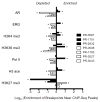The genomic complexity of primary human prostate cancer
- PMID: 21307934
- PMCID: PMC3075885
- DOI: 10.1038/nature09744
The genomic complexity of primary human prostate cancer
Abstract
Prostate cancer is the second most common cause of male cancer deaths in the United States. However, the full range of prostate cancer genomic alterations is incompletely characterized. Here we present the complete sequence of seven primary human prostate cancers and their paired normal counterparts. Several tumours contained complex chains of balanced (that is, 'copy-neutral') rearrangements that occurred within or adjacent to known cancer genes. Rearrangement breakpoints were enriched near open chromatin, androgen receptor and ERG DNA binding sites in the setting of the ETS gene fusion TMPRSS2-ERG, but inversely correlated with these regions in tumours lacking ETS fusions. This observation suggests a link between chromatin or transcriptional regulation and the genesis of genomic aberrations. Three tumours contained rearrangements that disrupted CADM2, and four harboured events disrupting either PTEN (unbalanced events), a prostate tumour suppressor, or MAGI2 (balanced events), a PTEN interacting protein not previously implicated in prostate tumorigenesis. Thus, genomic rearrangements may arise from transcriptional or chromatin aberrancies and engage prostate tumorigenic mechanisms.
Conflict of interest statement
The authors declare no competing financial interests.
Figures




Similar articles
-
Expression profile of MAGI2 gene as a novel biomarker in combination with major deregulated genes in prostate cancer.Mol Biol Rep. 2014 Sep;41(9):6125-31. doi: 10.1007/s11033-014-3491-0. Epub 2014 Jul 2. Mol Biol Rep. 2014. PMID: 24985972
-
TMPRSS2 fusions with oncogenic ETS factors in prostate cancer involve unbalanced genomic rearrangements and are associated with HDAC1 and epigenetic reprogramming.Cancer Res. 2006 Nov 1;66(21):10242-6. doi: 10.1158/0008-5472.CAN-06-1986. Cancer Res. 2006. PMID: 17079440
-
PTEN genomic deletion is an early event associated with ERG gene rearrangements in prostate cancer.BJU Int. 2011 Feb;107(3):477-85. doi: 10.1111/j.1464-410X.2010.09470.x. BJU Int. 2011. PMID: 20590547
-
Genetic, Environmental, and Nuclear Factors Governing Genomic Rearrangements.Adv Exp Med Biol. 2019;1210:57-66. doi: 10.1007/978-3-030-32656-2_3. Adv Exp Med Biol. 2019. PMID: 31900904 Review.
-
Oncogenic ETS Factors in Prostate Cancer.Adv Exp Med Biol. 2019;1210:409-436. doi: 10.1007/978-3-030-32656-2_18. Adv Exp Med Biol. 2019. PMID: 31900919 Review.
Cited by
-
Properties and Clinical Relevance of Speckle-Type POZ Protein in Human Colorectal Cancer.J Gastrointest Surg. 2015 Aug;19(8):1484-96. doi: 10.1007/s11605-015-2767-6. Epub 2015 May 29. J Gastrointest Surg. 2015. PMID: 26022775
-
Comprehensive genomic characterization of squamous cell lung cancers.Nature. 2012 Sep 27;489(7417):519-25. doi: 10.1038/nature11404. Epub 2012 Sep 9. Nature. 2012. PMID: 22960745 Free PMC article.
-
ERG orchestrates chromatin interactions to drive prostate cell fate reprogramming.J Clin Invest. 2020 Nov 2;130(11):5924-5941. doi: 10.1172/JCI137967. J Clin Invest. 2020. PMID: 32701507 Free PMC article.
-
Evidence for APOBEC3B mutagenesis in multiple human cancers.Nat Genet. 2013 Sep;45(9):977-83. doi: 10.1038/ng.2701. Epub 2013 Jul 14. Nat Genet. 2013. PMID: 23852168 Free PMC article.
-
An APOBEC cytidine deaminase mutagenesis pattern is widespread in human cancers.Nat Genet. 2013 Sep;45(9):970-6. doi: 10.1038/ng.2702. Epub 2013 Jul 14. Nat Genet. 2013. PMID: 23852170 Free PMC article.
References
-
- Jemal A, Siegel R, Xu J, Ward E. Cancer statistics, 2010. CA Cancer J Clin. 2010;60:277–300. - PubMed
-
- Tomlins SA, et al. Recurrent fusion of TMPRSS2 and ETS transcription factor genes in prostate cancer. Science. 2005;310:644–648. - PubMed
-
- Tomlins SA, et al. Distinct classes of chromosomal rearrangements create oncogenic ETS gene fusions in prostate cancer. Nature. 2007;448:595–599. - PubMed
-
- Helgeson BE, et al. Characterization of TMPRSS2:ETV5 and SLC45A3:ETV5 gene fusions in prostate cancer. Cancer Res. 2008;68:73–80. - PubMed
-
- Tomlins SA, et al. TMPRSS2:ETV4 gene fusions define a third molecular subtype of prostate cancer. Cancer Res. 2006;66:3396–3400. - PubMed
Publication types
MeSH terms
Substances
Grants and funding
LinkOut - more resources
Full Text Sources
Other Literature Sources
Medical
Molecular Biology Databases
Research Materials

